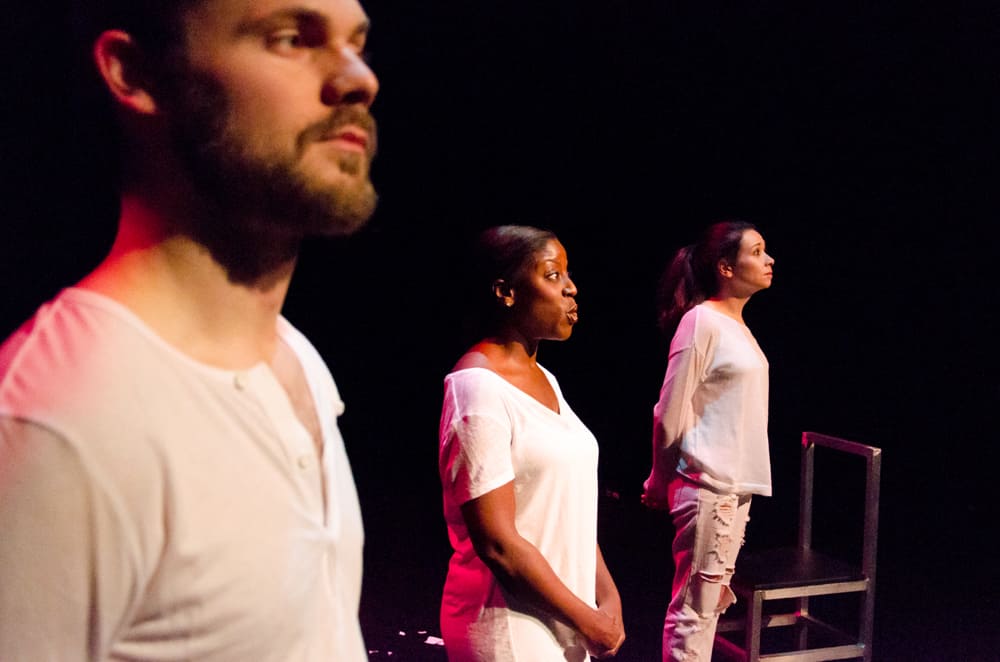Sarah Kane’s Dazzling Apologia Pro Morte Sua, 4.48 PSYCHOSIS, at Iron Crow
Posted October 10, 2014, on BroadwayWorld.com
“How on earth do you award aesthetic points to a 75-minute suicide note?” asked critic Michael Billington after seeing the original 2000 London production of Sarah Kane‘s 4.48 Psychosis, her final theater piece, staged 16 months after Kane’s self-inflicted death (by hanging in a psychiatric ward). The answer to Billington’s question is, you award aesthetic points to a suicide note the same way you award aesthetic points to anything else: Is it well-written, does it show you something new, does it move you? The answers to these follow-up questions, with this piece (which is admittedly impossible not to view as a suicide note) are yes, yes, and yes. And Iron Crow Theatre has given it simply an outstanding production.
Kane’s writing reminds me repeatedly of Dylan Thomas‘ poetry, with the telling repetitions and the evocative ambiguities of syntax. She can and does make excerpts from patient medical charts sing. So yes, it’s well-written.
Based on this and the one other Kane play I’m familiar with, Blasted, given a powerful staging at Towson University a couple of years ago, I’m convinced Kane could never be anything other than original and shocking in the way she rips all comfort away, and forces audiences to confront tragedy and fear and strangeness. Here, she depicts in full force the utter aloneness of the suicidally depressed, because the revoltingness of life which is their omnipresent reality seems invisible to those who treat them, and the suicidal person’s responses to this revoltingness, like anomie and self-cutting and suicide attempts, feel like such relief but are so discouraged. Kane manages to make us understand that perspective. So yes it shows us something most of us will find new.
4.48 Psychosis is involving from one end to the other, a ritual of speech, movement, and gesture that picks you up and does not put you down, even when it repeats itself somewhat (e.g. the voices of therapists telling the sufferers that they are not to blame for their condition, or that the therapists like the sufferers). With this piece, you cannot not look into the void. So yes, it moves you.
And I have nothing but praise for this staging. Director Ryan Clark and Movement Director Nick Horan make so much out of so little: basically three chairs, a length of white rope, and three performers (Horan, Katie Keddell and Ché Lyons) dressed in white and usually framed against darkness, with an assist from visual projections above and to the sides of the performers. Much can be made with these simple elements. For instance, Horan demonstrates the power of the self-destructiveness he drags into interactions with an uncomprehending world by tying the rope around two of the chairs which have been knocked on their side, and pulling them screeching around the stage as he goes to meet a therapist. At another point the rope becomes a noose. At another time, during the medical charts sequence, the side projections reflect a succession of stylized prescription vials, a little bit of gallows humor (if that word may be permitted in this context).
A peculiarity of this piece is that Kane did not specify the number of performers to participate. There are voices but no consistent characters. The original production featured three performers, the number here. Horan, Keddell and Lyons manage to switch rapidly among the voices, principally the despairing and their therapists, and to find depth and characterization even in the sketchiest of temporary roles.
This show does not have a long run (it ends October 18), and I was delayed in getting a chance to review it. So I must counsel you to waste no time, tear yourself away from the comfortable and familiar, and see it before it’s gone. Stare into the void for awhile.
Copyright (c) Jack L. B. Gohn, except for production photo. Credit: Zachary Z. Handler.


 I lived in London and Vienna before coming to the United States, and grew up mainly in Ann Arbor. I was writing plays and stories as early as grade school. My undergraduate years at the University of Pennsylvania, where I first reviewed theater, for the college paper, were succeeded by graduate study at the Johns Hopkins University, where I earned a doctorate in English Literature.
I lived in London and Vienna before coming to the United States, and grew up mainly in Ann Arbor. I was writing plays and stories as early as grade school. My undergraduate years at the University of Pennsylvania, where I first reviewed theater, for the college paper, were succeeded by graduate study at the Johns Hopkins University, where I earned a doctorate in English Literature.